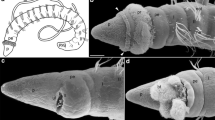Abstract
The free-swimming medusae of Eirene viridula are typical marine hydroids, with distinct subdivisions into body regions, which were studied by comparison of light and electron microscopy. Particular attention is given to the epithelio-muscular and digestive muscle cells. The epidermis — apart from a few nerve cells and cnidocytes-consists of epitheliomuscular cells. At their bases these cells form a musculature and at the apex many secretory vesicles. In the velum, large expansions of the intercellular space are found. The gastrodermis — apart from the mucous and zymogen cells in the manubrium — consists of digestive muscle cells, the structure of which corresponds in principle to that of the epitheliomuscular cells. In its apex, this type of cells contains both “normal” coated vesicles and discoidal coated vesicles. In the solid tentacles, the digestive muscle cells form a turgescent vesicular tissue. The central nervous system consists of the exumbrellar, subumbrellar, and gastrodermal nerve rings. They are composed of ganglion cells, their processes, and intraepithelial flagella. The static organs are purely ectodermal statocysts which have only one lithocyte and only one sensory cell.
Similar content being viewed by others
Literature Cited
Bierbach, M. und D.K. Hofmann: Experimentelle Untersuchungen zum Stockwachstum und zur Medusenbildung bei dem marinen Hydrozoon Eirene viridula. Helgoländer wiss. Meeresunters. 25, 63–84 (1973)
Bouillon, J.: Introduction to coelenterates. In: Chemical zoology II: Porifera, Coelenterata and Platyhelminthes, pp 81–145. Ed. by M. Florkin and B.T. Scheer. New York & London: Academic Press 1968
Chapman, D.M.: Cnidarian histology. In: Coelenterate biology, pp 1–92. Ed. by L. Muscatine and H.M. Lenhoff. New York & London: Academic Press 1974
— and R. James: Intraepithelial flagella in the medusa of Aurelia aurita (L.). Publs Seto mar. biol. Lab. 20, 731–743 (1973)
—, C.F.A. Pantin and E.A. Robson: Muscle in coelenterates. Revue can. Biol. 21, 267–278 (1962)
Gauthier, G.: Cytological studies on the gastroderm of Hydra. J. exp. Zool. 152, 13–19 (1963)
Günzl, H.: Untersuchungen über die Auslösung der Medusenknospung bei Hydroidpolypen. Zool. Jb. (Abt. Anat. Ont. Tiere) 81, 491–528 (1964)
Horridge, G.A.: The nerves and muscles of medusae. II. Geryonia proboscidalis Eschscholtz. J. exp. Biol. 31, 555–568 (1955)
—: Statocysts of medusae and evolution of stereocilia. Tissue Cell 1, 341–353 (1969)
— and B. Mackay: Naked axons and symmetrical synapses in coelenterates. Q. Jl microsc. Sci. 103, 531–541 (1962)
Hündgen, M.: Potential and limitations of enzyme cytochemistry: studies of the intracellular digestive apparatus of cells in tissue culture. Int. Rev. Cytol. 48, 281–321 (1977)
—: The biology of colonial hydroids. I. The morphology of the polyp of Eirene viridula (Thecata: Campanulinidae). Mar. Biol. 45, 79–92 (1978)
Jha, R.K. and G.O. Mackie: The recognition, distribution, and ultrastructure of hydrozoan nerve elements. J. Morph. 123, 43–63 (1967)
Keough, E.M. and R.G. Summers: An ultrastructural investigation of the striated subumbrellar musculature of the anthomedusa Pennaria tiarella. J. Morph. 149, 507–526 (1975)
Lentz, T.L.: The cell biology of Hydra, 196 pp. Amsterdam: North Holland Publishing Co. 1966
Meurer, M. und M. Hündgen: Licht- und elektronen-mikroskopischer Bau der Süßwassermeduse Craspedacusta sowerbii (Hydrozoa, Limnohydrina). Zool. Jb. (Abt. Anat. Ont. Tiere) (1978). (Im Druck)
Roosen-Runge, E.C.: Gastrovascularsystems of small hydromedusae: mechanisms of circulation. Science, N.Y. 156, 74–76 (1967)
Singla, C.L.: Statocysts of hydromedusa. Cell Tissue Res. 158, 391–407 (1975)
Slautterback, D.B.: Coated vesicles in absorptive cells of Hydra. J. Cell Sci. 2, 563–572 (1967)
Tardent, P. and F. Stössel: Die Mechanorezeptoren der Polypen von Coryne pinteri, Sarsia reesi und Cladonema radiatum. Revue suisse Zool. 78, 680–688 (1971)
Werner, B.: Halmmohydra Remane. Medusennatur und Stellung im System. Zool. Anz. (Suppl.) 28, 163–178 (1964)
Westfall, J.A.: Ultrastructure of synapses in a primitive coelenterate. J. Ultrastruct. Res. 32, 237–246 (1970)
Author information
Authors and Affiliations
Additional information
Communicated by O. Kinne, Hamburg
Rights and permissions
About this article
Cite this article
Germer, T., Hündgen, M. The biology of colonial hydroids. II. The morphology and ultrastructure of the medusa of Eirene viridula (Thecata-Leptomedusa: Campanulinidae). Mar. Biol. 50, 81–95 (1978). https://doi.org/10.1007/BF00390544
Accepted:
Issue Date:
DOI: https://doi.org/10.1007/BF00390544




